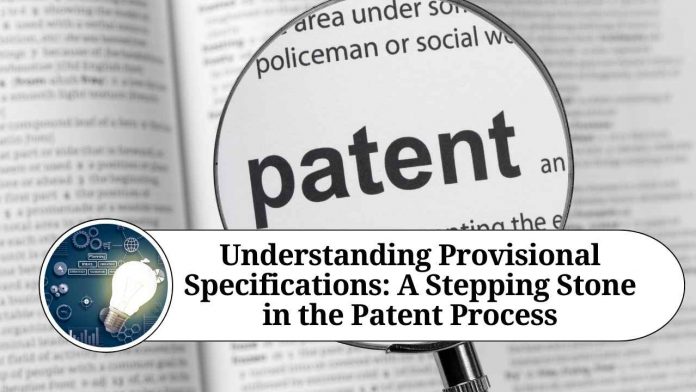Introduction
When it comes to protecting intellectual property, patents play a crucial role. Patents grant inventors exclusive rights to their inventions, ensuring that their ideas are safeguarded and providing them with the opportunity to commercialize their innovations. One important step in the patent process is filing a provisional specification, which serves as a preliminary document that establishes an early priority date for an invention. In this blog post, we will explore the concept of provisional specifications and shed light on their significance in the world of patents.
What is a Provisional Specification?
A provisional specification is a concise, temporary document submitted to a patent office to establish a filing date for an invention. It acts as a placeholder, providing inventors with a one-year period to further develop and refine their invention before filing a complete patent application. Unlike a non-provisional application, a provisional specification does not require formal claims or an oath or declaration. It serves as a provisional protection mechanism for inventors while they fine-tune their inventions and gather additional evidence to support their claims.
Benefits and Significance:
- Establishing Priority: By filing a provisional specification, an inventor secures an early priority date. This date becomes crucial when determining the novelty and non-obviousness of the invention. In the event that someone else files a patent application for a similar invention, the inventor with the earlier priority date is generally considered the original creator.
- Extended Development Period: Filing a provisional specification allows inventors to gain an additional year to refine their inventions and assess their market viability before committing to the more complex and costly process of filing a complete patent application. This flexibility is particularly beneficial when inventors need additional time to conduct further research, perform experiments, or seek funding for their projects.
- Cost Savings: Provisional specifications are typically less expensive to file than non-provisional patent applications. Since they do not require formal claims or certain formalities, inventors can save money during the initial stages of the patent process.
- Confidentiality: Filing a provisional specification allows inventors to protect their ideas without fully disclosing them to the public. While the provisional specification is not published, it provides a secure date of invention, which can be crucial in case of disputes or potential infringement.
Conversion to Non-Provisional Application: To fully protect an invention, inventors must convert their provisional specification into a non-provisional patent application within one year of the initial filing. The non-provisional application includes the complete set of claims, formal drawings (if applicable), and a detailed description of the invention. The priority date established by the provisional specification is carried forward to the non-provisional application.
It is important to note that the protection offered by a provisional specification is contingent upon the inventor’s ability to adequately describe the invention in the non-provisional application. Therefore, it is crucial to ensure that the provisional specification includes sufficient information to support the claims made in the non-provisional application.
Conclusion
Provisional specifications play a vital role in the patent process, providing inventors with a temporary and cost-effective means of establishing an early priority date for their inventions. By filing a provisional specification, inventors gain additional time to refine their ideas, assess market viability, and gather necessary evidence before committing to a complete patent application. Understanding the significance of provisional specifications empowers inventors to navigate the patent process more effectively and protect their intellectual property rights.
Other Related Blogs: Section 144B Income Tax Act
Frequently Asked Questions (FAQs)
Q: What is a provisional specification?
A: A provisional specification is a temporary document filed with a patent office to establish an early priority date for an invention. It serves as a preliminary placeholder that provides inventors with a one-year period to further develop and refine their invention before filing a complete patent application.
Q: What is the purpose of filing a provisional specification?
A: Filing a provisional specification offers several benefits. It helps establish an early priority date for the invention, provides inventors with additional time to develop and assess their invention, allows cost savings compared to filing a non-provisional application, and offers confidentiality by protecting the invention without fully disclosing it to the public.
Q: Can a provisional specification be granted a patent on its own?
A: No, a provisional specification cannot be granted a patent on its own. It serves as a temporary measure to establish a filing date and secure priority rights. To obtain a patent, inventors must convert their provisional specification into a non-provisional patent application within one year of the initial filing.
Q: What are the requirements for filing a provisional specification?
A: The requirements for filing a provisional specification vary depending on the jurisdiction, but generally, the document should include a description of the invention, enabling disclosure of the invention, and any relevant drawings (if applicable). Unlike non-provisional applications, provisional specifications do not require formal claims or an oath or declaration.
Q: How long does a provisional specification provide protection?
A: A provisional specification provides temporary protection for a period of one year from the date of filing. Within this one-year period, inventors must convert the provisional specification into a non-provisional application to maintain their priority rights and continue the patent process.
Q: Can a provisional specification be extended beyond one year?
A: No, the one-year period provided by a provisional specification is generally fixed and cannot be extended. It is important to convert the provisional specification into a non-provisional application within this timeframe to maintain priority rights and continue the patent process.
Q: Can multiple provisional specifications be filed for the same invention?
A: Yes, multiple provisional specifications can be filed for the same invention, either by the same inventor or different inventors. However, it is important to ensure that the subsequent non-provisional application claims priority to the earliest-filed provisional specification to maintain the original priority date.
Q: Can changes be made to a provisional specification after filing?
A: No, once a provisional specification is filed, it cannot be amended or changed. However, inventors have the option to file a new provisional specification to include any updates or modifications to their invention. In such cases, it is essential to maintain the original priority date from the earliest-filed provisional specification.
Q: Is a provisional specification published or made public?
A: No, provisional specifications are generally not published or made public. They are kept confidential, providing inventors with a means to protect their ideas without fully disclosing them. The confidentiality of the provisional specification allows inventors to assess the market viability of their invention before filing a complete patent application.
Q: Can an invention be patented without filing a provisional specification?
A: Yes, it is possible to directly file a non-provisional patent application without first filing a provisional specification. However, filing a provisional specification offers certain benefits, such as establishing an early priority date, gaining additional time for development, and saving on initial costs. The decision to file a provisional specification depends on the specific circumstances and strategies of the inventor.




















